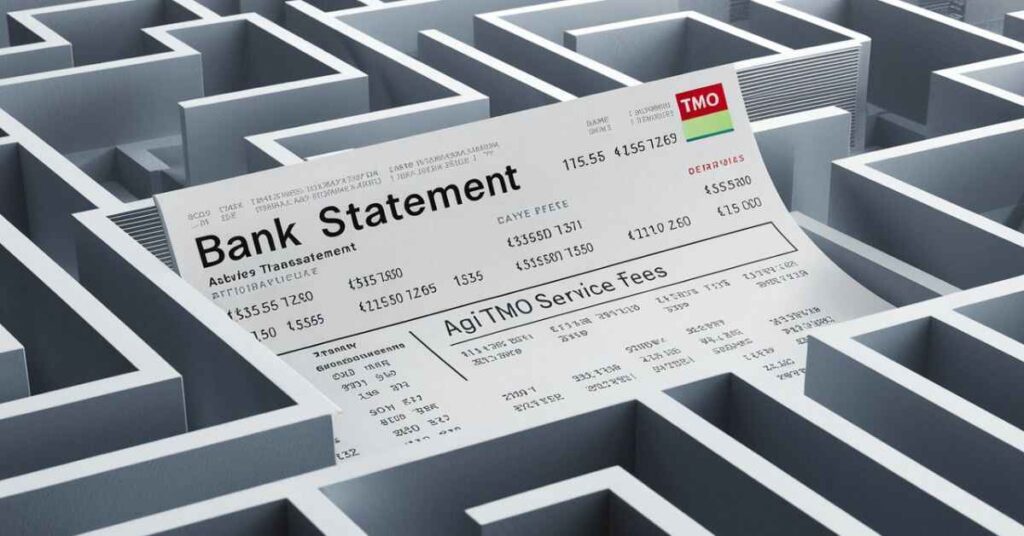Have you ever meticulously gone through your bank statement only to be met with an unfamiliar charge like “AGI TMO Service Fees”? As comprehensible as ancient hieroglyphics, such fee descriptions leave most consumers scratching their heads in confusion. But understanding exactly what you’re being charged for is crucial for proper financial transparency and accountability. AGI TMO Service Fees Charge on Bank Statement: What You Need to Know.
The Purpose Behind AGI TMO Service Fees on Bank Statements
At its core, an “AGI TMO Service Fees” charge represents the cost of using third-party payment processors to facilitate various transactions. These fees are not unique to banking – they’re prevalent across many industries wherever digital payments are enabled by intermediary processors.
From ordering takeout online to renewing your streaming subscriptions, chances are a small “AGI TMO” or similarly coined fee has inconspicuously made its way onto one of your monthly statements. The businesses you frequent get charged this processing fee, which they may pass onto you, the consumer.
Decoding the Term “AGI TMO Service Fees”

Before demystifying these fees, let’s first dissect the jumbled acronym:
AGI stands for “Automated Clearing House (ACH) Gateway Interface.” This refers to the payment infrastructure that enables electronic fund transfers from one banking account to another.
TMO represents “Telecommunications / Merchant / Other,” encompassing the various businesses and industries leveraging these third-party payment services.
So in plain English, “AGI TMO Service Fees” essentially translates to charges for utilizing intermediaries that facilitate digital payments – possibly the most coherent three-letter acronym in the financial world.
Understanding How AGI TMO Service Fees Are Calculated
Much like the naming conventions, the specific calculation methods for AGI TMO fees can vary across payment processors and industries. However, some key factors commonly influence the amount charged:
- Transaction Volume: Higher volumes often merit lower per-transaction fees based on negotiated rates with the processor.
- Payment Processing Methods: Fees may differ for card payments (credit/debit) versus ACH bank transfers or mobile wallets.
- Contract Terms: Businesses with higher transaction volumes can leverage better pricing tiers and models when negotiating contracts.
- Industry Pricing Models: Different sectors like retail, hospitality, and banking have their typical fee structures from major processors.
At the end of the day, it’s fundamentally a cost of doing business in our digital economy. The more seamlessly and securely a company wants to enable payments, the more it will pay third-party experts to handle the heavy lifting.
How AGI TMO Service Fees Vary Across Industries
While the concept is universal, AGI TMO fees go by many different monikers across major sectors:
- Finance & Banking
In the banking world, you’re more likely to see them grouped vaguely as “Processing Fees” on your statements. - Telecommunications
Telco companies often call them “Third-Party Processor Convenience Fees” for payment processing services. - E-commerce & Retail
For online retailers and brands, they commonly appear as “Payment Gateway Charges” to facilitate digital transactions. - Subscription Services
Streaming platforms, software, media subscriptions, and more tend to list them as “Transaction Processing Costs.” - Hospitality & Food Service
Restaurants, hotels, and others in this space usually refer to them as “Merchant Services Fees.”
The semantics may differ, but they all represent the same concept – paying to play in our increasingly cashless society. AGI TMO Service Fees Charge on Bank Statement: What You Need to Know.
Quirky Fees: AGI TMO and Other Odd Charges
When it comes to random fees levied on consumers, “AGI TMO Service Fees” are just the tip of the iceberg. Many major companies have gotten creative with jargon-laden charges like:
- “Utility Rental Fees” – Added costs for leasing utility equipment like cable boxes, modems, etc.
- “Fuel Surcharges” – Those pesky fees airlines love tacking on to cover fluctuating fuel costs.
- “Membership Fees” – From wholesale clubs to Amazon Prime, annual charges for the privilege of accessing special services.
- “Inactivity Fees” – The fun tax some banks levy if you don’t use your account frequently enough!
The list goes on, but one thing’s for sure – buried fees are big business for companies looking to pad their profit margins. Being an informed consumer is key.
Streamlining Fees: The Future Landscape
Recognizing that convoluted fee structures only breed distrust, many businesses and industries are evolving toward simplicity and transparency:
- Clear Fee Itemization: Rather than obfuscating charges, more companies are clearly breaking out individual fees on bills.
- All-In Pricing Models: To avoid sticker shock, some providers are baking processing costs into advertised rates instead of tacking them on later.
- Innovative Payment Tech: New decentralized models like cryptocurrency aim to remove intermediaries and their associated fees entirely.
Furthermore, consumer protection regulations are starting to demand clearer fee disclosure practices across sectors like banking, utilities, telecoms, and more. AGI TMO Service Fees Charge on Bank Statement: What You Need to Know.
Strategies to Effectively Manage “AGI TMO Service Fees” Charges
While AGI TMO fees may seem unavoidable, there are some tactics businesses and consumers can use to monitor and potentially reduce these costs:
For Businesses:
- Regularly review processor rates and terms: Don’t settle for antiquated, overpriced contracts. Renegotiate routinely.
- Streamline payment processing methods: Using fewer unique payment types can simplify fee structures and create economies of scale.
- Consider consolidating payment processors: Having multiple processors creates redundant fee layers that can be eliminated.
- Pass fees to customers transparently: If you can’t avoid them, at least itemize the charges clearly so customers understand what they’re paying for.
For Consumers:
- Review statements regularly: Keep an eye out for any surprise fees or unexplained charges.
- Negotiate with service providers: Don’t take rates and fees as set in stone – everything is negotiable.
- Leverage autopay or preauthorized payment plans: These methods can sometimes qualify for reduced processing fees from companies.
Distinguishing AGI TMO Fees from Transaction Fees, Interest Charges, and More
To the untrained eye, “AGI TMO Service Fees” charges can easily blur together with other common bank fees. Here’s a quick overview of some key differences:
| Fee Type | What It Is | When It’s Charged |
|---|---|---|
| AGI TMO Processing Fees | Charges by third-party payment processors for facilitating transactions | Any time an electronic payment is processed, based on factors like transaction size, volume, payment method, etc. |
| Transaction Fees | Flat per-transaction charges, often for services like wire transfers or excessive withdrawals | Each time a qualifying transaction is conducted |
| Annual Fees | Yearly membership/account maintenance charges | Once per year, usually on the anniversary of opening an account |
| Overdraft Fees | Penalty charges for overdrawing from an account with insufficient funds | Each time an overdraft occurs on the account |
Understanding these distinctions ensures you know exactly what you’re paying for – and can identify any duplicates, errors, or potentially abusive practices.
The Fine Print: Legal and Regulatory Considerations
As frustrating as they can be, AGI TMO and other processing fees are legally permissible charges by banks and businesses. However, there are some regulatory parameters around clearly disclosing and itemizing such fees:
- The Truth in Lending Act mandates clear disclosure of fees and APRs from lenders.
- Consumer protection laws like the CARD Act restrict certain credit card fees and billing practices.
- Specific states and industries have their own disclosure rules regarding processing/service fees added to bills.
- The Federal Trade Commission requires fees to be properly represented in any cost advertising.
While the regulations help, they don’t make the fees any less confusing to most consumers. Continued clarity and transparency from businesses themselves is key to fostering trust.
Conclusion
Love them or hate them, charges like “AGI TMO Service Fees” reflect the complexities and often opaque costs of our increasingly cashless economy. Understanding their purpose – paying third-party payment facilitators to handle secure transactions seamlessly – is an important first step.
Despite seeming as baffling as hieroglyphics, regularly reviewing these fees and other charges can empower consumers and businesses to make informed decisions. While complete avoidance may not be realistic, at least we can demystify the meaning behind those abbreviated service fees adorning our monthly statements. CopyRetry
FAQs
Ans: AGI TMO (Automated Clearing House – Third-Party Merchant Originators) service fees are charges that may appear on your bank statement when you make certain types of payments or transactions. These fees are typically associated with electronic funds transfers or ACH payments processed through third-party merchant originators.
Ans: AGI TMO service fees are charged by banks or financial institutions to cover the costs of processing electronic payments and transactions initiated by third-party merchant originators. These fees help offset the administrative and processing expenses associated with these types of transactions.
Ans: The amount of AGI TMO service fees can vary depending on the financial institution, the type of transaction, and the third-party merchant originator involved. Commonly, these fees range from $0.25 to $1.50 per transaction.
Ans: In some cases, you may be able to avoid AGI TMO service fees by using alternative payment methods or negotiating with your financial institution. However, the availability and feasibility of avoiding these fees will depend on your specific circumstances and the policies of your bank or payment processor.
Ans: AGI TMO service fees are typically labeled as such on your bank statement, often appearing as “AGI TMO” or “Third Party Merchant Originator” fees. If you’re unsure about a specific charge, you can contact your financial institution for more information.





